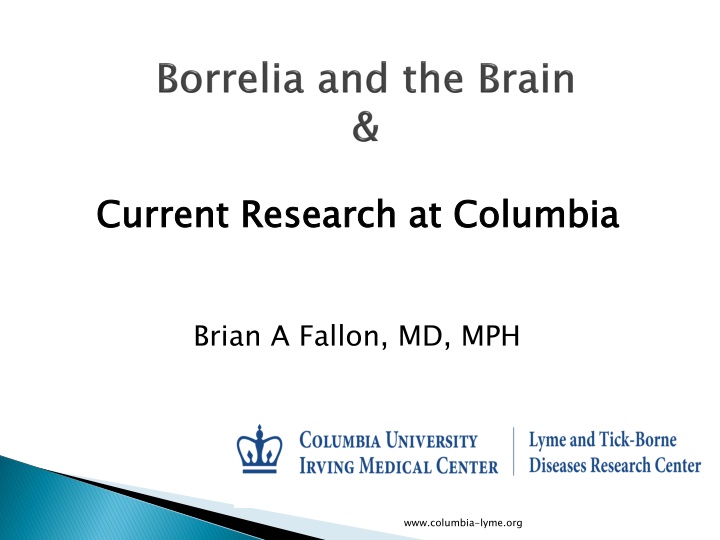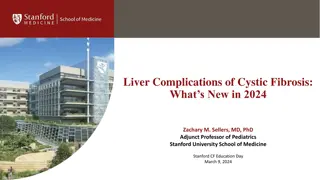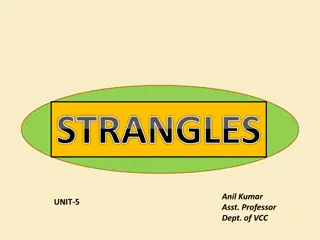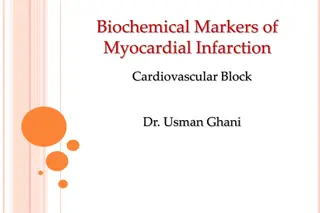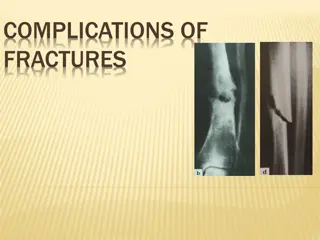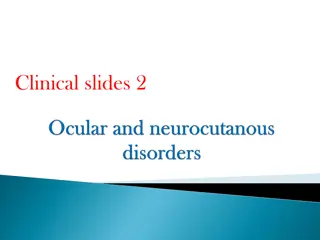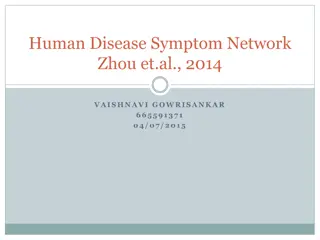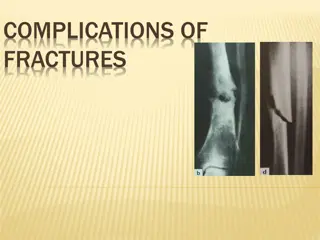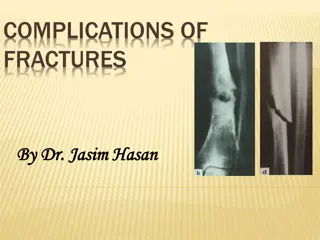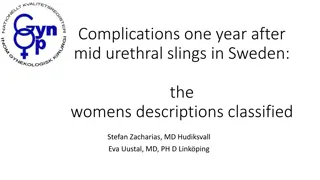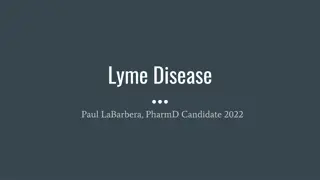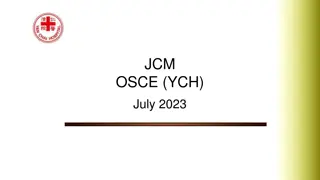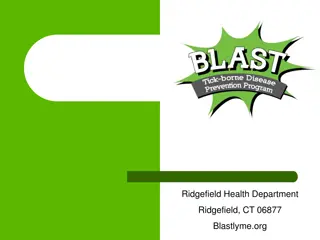Neurological Complications of Lyme Disease: Symptoms and Markers
In patients with Lyme disease, various neurological complications can arise, including inflammation of brain tissues, cranial nerves, and membranes around the brain. Symptoms range from headaches and neck stiffness to cognitive changes, mood swings, and sensory numbness. Specific markers, such as elevated white blood cells in cerebrospinal fluid and Borrelia-specific antibodies, help in diagnosing these conditions. Prompt recognition and treatment of these neurological manifestations are crucial for better outcomes in Lyme disease management.
Download Presentation

Please find below an Image/Link to download the presentation.
The content on the website is provided AS IS for your information and personal use only. It may not be sold, licensed, or shared on other websites without obtaining consent from the author.If you encounter any issues during the download, it is possible that the publisher has removed the file from their server.
You are allowed to download the files provided on this website for personal or commercial use, subject to the condition that they are used lawfully. All files are the property of their respective owners.
The content on the website is provided AS IS for your information and personal use only. It may not be sold, licensed, or shared on other websites without obtaining consent from the author.
E N D
Presentation Transcript
Current Research at Columbia Current Research at Columbia Brian A Fallon, MD, MPH www.columbia-lyme.org
Inflammation of membranes around the brain. Symptoms: Headaches, neck stiffness, Nausea/vomiting Light sensitivity, fever Markers: Cerebrospinal fluid shows elevated white blood cells Elevated Borrelia-specific antibodies in the CSF Sometimes elevated protein www.columbia-lyme.org
Inflammation of the brain tissue Symptoms: Sleepiness Neurologic: confusion, cognitive changes, seizures Psychiatric: Mood swings, mood lability, sudden tearfulness Hallucinations Personality or behavior changes Brain Markers: EEG mild slowing; MRI focal inflammation PET scan areas of increased metabolism or flow Spinal fluid may show oligoclonal bands, Bb antibodies www.columbia-lyme.org
Inflammation of cranial nerves Facial nerve palsy CN VII sudden suggests a stroke on one or both sides also may have eye tearing, sound sensitivity, altered taste Optic nerve (CN II) change in vision Involvement of other cranial nerves: changes in facial sensation (CN V - trigeminal) double vision (CN III, IV, VI) hearing loss, ringing in the ears (tinnitus), balance CN VIII (auditory/balance) www.columbia-lyme.org
Increased intracranial pressure may lead to compression of the optic nerve. Most common in children & young adults Symptoms: Blurred vision, double vision, loss of vision Feeling dizzy, nausea/vomiting Neck stiffness, Frequent headaches, difficulty walking Persistent ringing in the ears (tinnitus) Forgetfulness, Depression Markers: Swelling of the optic disc Elevated spinal fluid pressure Sometimes increased # of CSF WBC www.columbia-lyme.org
Nerve dysfunction due to inflammation of the roots of the spinal nerve. Pain can be the most severe ever Symptoms: Sensory numbness, tingling, increased sensitivity sharp, stabbing, burning or shooting pains that radiate along the nerves. Can be intermittent and worse at night. Sensory: Motor affected by the inflamed nerve (eg, limbs) Motor: can get weakness in the areas www.columbia-lyme.org
NOTE: In Europe, presentation of is slowest to recognize. In Europe, radicular presentation of Neuroborreliosis is slowest to recognize. radicular pain is the most common Neuroborreliosis (~60%) pain is the most common (~60%) and the one that and the one that There may not be fever, cranial neuropathy or severe headaches this leads to delays in treatment and increased frequency of residual symptoms 44% had residual symptoms if treatment is >1month after symptom onset vs 16% for those treated within 1 month of symptom onset (Knudtzen, Clinical Inf Disease, 2017). www.columbia-lyme.org
Cognitive changes verbal fluency, memory, processing speed Cognitive changes Mood changes Mild to moderate depressed mood is common Anxiety and panic attacks Suicidal thoughts in 20% when symptoms are chronic Mood changes: Sensory Sensory hyperarousal hyperarousal (light, sound, touch) Excessive sleepiness, fatigue, & pain Excessive sleepiness, fatigue, & pain Less common or rare Mania, hallucinations, dementia Less common or rare: www.columbia-lyme.org
PCR of the CSF is + only 25-38% of the time The CSF may not show intrathecal antibody production using the routine Lyme tests. In our study, 12.5% were positive using the standard ELISA in the CSF .but 60% were positive using the C6 Peptide ELISA as the CSF test. The CSF may be the only fluid that shows a positive test for Lyme disease In a recent Danish study, 15% of the patients with spinal fluid positive neurologic Lyme disease had negative blood tests for Lyme disease (Clinical Infectious Disease 2017) www.columbia-lyme.org
Epidemiologic Study Danish National Cohort Study to assess risk of Psychiatric Disorders & Suicidality after Lyme Epidemiologic Study Coinfection Coinfection Study Study (with Tokarz Tick Serochip) Clinical Studies seeking Patients Powassan Virus Study Clinical Studies seeking Patients: Disulfiram Treatment Study Meditation and Yoga Treatment Study www.columbia-lyme.org
NIH Grant PI: Margaret MacDonald, MD, PhD (Rockefeller University). Site PI: Brian Fallon, MD, MPH (Columbia) Goals: a) an improved diagnostic test b) development of a treatment How can you help? You can help TODAY Come to our blood draw research screening clinic the Hudson Valley Healing Arts Health Center Lyme and Powassan Virus test. Results will be sent to you by mail. Office of Dr. Richard Horowitz How can you help? You can help TODAY. Come to our blood draw research screening clinic at Hudson Valley Healing Arts Health Center for a free 4232 Albany Post Rd, Hyde Park, NY 12538 www.columbia-lyme.org
Found in 3-4% of ticks in lower NYS Can be transmitted within 15 minutes of bite Most POWV infections do not cause symptoms CNS Manifestations: encephalitis & meningitis fever, headache, vomiting, weakness, confusion, loss of coordination, speech difficulties, and seizures. Neuroinvasive Powassan Virus 10% death neurological symptoms muscle wasting and memory problems Treatment: none, other than supportive measures 10% death. neurological symptoms, such as recurrent headaches, . 50% of survivors have permanent 50% of survivors have permanent www.columbia-lyme.org
Powassan virus neuroinvasive disease case rates are increasing: 2008 2017, CDC Source: ArboNET, Arboviral Diseases Branch, Centers for Disease Control and Prevention www.columbia-lyme.org
STATES with the Highest Number of Cases: Minnesota, Wisconsin, NY, and Massachusetts NY had 6 cases in 2017 www.columbia-lyme.org
Two Groups (age 18-75): Lyme Group (n=160) Lyme Group (n=160): Diagnosed with LD in the past 5 years Healthy Control Group (n=40) illness, no tick bite or flu-like illness in the last 6 months, and medically healthy Healthy Control Group (n=40): no diagnosis of Tick-borne Willing to complete questionnaires, sign consent, and have blood drawn. The first 200 will be eligible. Location: Hudson Valley Healing Arts Health Center, 4232 Albany Post Rd, Hyde Park, NY (3:30 Hudson Valley Healing Arts Health Center, 4232 Albany Post Rd, Hyde Park, NY (3:30- -8:30) 8:30) www.columbia-lyme.org
Based on laboratory research at Stanford Univ and Northeastern University Disulfiram kills both actively replicating Borrelia actively replicating persisters Borrelia and the more dormant persisters Disulfiram has been in use for over 70 years for the treatment of alcoholism Initial clinical reports (Dr. Liegner) among patients with persistent Lyme symptoms are encouraging www.columbia-lyme.org
To assess symptom change Do patients improve? Which clinical symptoms respond best? What is the magnitude of the clinical improvement? Does duration of treatment make a difference? Is improvement sustained when off of disulfiram To assess side effect profile, tolerance and compliance. This is a research study. There will be no financial cost for participation. www.columbia-lyme.org
Borrelia tests done experimentally. Borrelia and and Babesia Babesia for screening. Other coinfection Neurologic studies Autonomic function Heart rate variability Sweat gland function Sensory Sensitivity (light, touch, sound, heat) Full Neurologic exam Neurocognitive testing Functional brain imaging (if you participate in imaging study) Neurologic studies: Clinical measures function, cognition, quality of life. Clinical measures: fatigue, pain, physical and mental Microbiome Microbiome: fecal matter studies www.columbia-lyme.org
Age 18-65 Persistent moderate to severe fatigue after well-documented Lyme within the last 8 years Willing to avoid: antibiotics for 3 months prior and during the study all alcohol & cannabis Patients with unstable other medical illness or history of cardiac or liver disease are excluded www.columbia-lyme.org
Last chance to enroll. Group session weekly for 8 weeks Location: Fairfield CT Leader: Dr. Charles Alexander Eligible: Age 18-65 Prior treatment for Lyme disease but still have persistent pain and/or fatigue Willing to do daily meditation/yoga for 8 weeks and attend group session 1x week. Prior treatment for Lyme disease but still have persistent pain and/or fatigue www.columbia-lyme.org
Please participate in the blood screening clinic today (until 8:30 pm for first 160 patients and 40 healthy controls) at Dr. Horowitz office at 4232 Albany Post Rd, Hyde Park Please contact us if interested in our Treatment Studies isulfiram s study 646-774-6491 (Jess) Meditation/Yoga Enrolling NOW! Please contact us if interested in our Treatment Studies D Disulfiram Meditation/Yoga study 646-774- 8100 (Lilly) www.columbia-lyme.org
Website: www.columbia-lyme.org Book: Conquering Lyme Disease (Columbia Press, paperback) Winner, 2019 Choice Award (All Proceeds support research) www.columbia-lyme.org
Dutchess County Legislature Dr. Richard Horowitz, Dr. Ken Liegner NIH, FDC Foundation, Cohen Foundation, Global Lyme Alliance, New York State Our team: www.columbia-lyme.org
